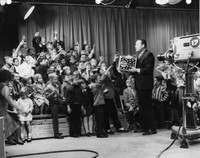
'Wee Willie Webber's Colorful CartoonClub' was one of several popular children's television programs to air in the Philadelphia area.
CAMDEN — They came into living rooms with a song and a story,
connecting with children across the Philadelphia area through their television
sets.
Although Captain Noah, Sally Starr, and other popular children’s
television hosts are no longer on the air, Rutgers–Camden researchers say children
are still connecting with television personalities, but in much different ways.
“Children who grew up during the 1950s and 1960s had with their
television friends a strong, emotional bond that doesn’t exist today,” says
Vibiana Bowman Cvetkovic, a reference librarian at the Paul Robeson Library on
the Rutgers–Camden campus.
“Today, there are different ways to interact,” she says. “Children
can connect through the internet. They can tweet their favorite shows.”
A Collingswood resident, Cvetkovic is a Ph.D. candidate in
Rutgers–Camden’s childhood studies program and is a member of the Broadcast
Pioneers of Philadelphia, a nonprofit organization that promotes broadcast-related causes and preserves the history
of television and radio in Philadelphia.
In an essay published in the Encyclopedia of Greater Philadelphia and
co-authored with Rutgers–Camden graduate Brandi Scardilli, Cvetkovic details
the evolution of children’s television in Philadelphia beginning with the rise
of the “golden age of television,” when original children’s shows were produced
by three local broadcast affiliates.
“Philadelphia
was always an important player in the communications industry and that’s also
true for locally produced children’s television programming,” says Cvetkovic,
who received her master’s degree in liberal studies from Rutgers–Camden and her
master’s degree in library science from Drexel University.
Most of the shows followed the same formula. Personalities like
Bill Webber on “Wee Willie Webber’s Colorful Cartoon Club” or Sally Starr on
“Popeye Theater” would interact with the child viewers (or a studio audience), do
the commercials for local sponsors, and introduce the cartoon shorts.
“I think the thing that made the early children’s TV shows popular
was that they were local people,” Cvetkovic says. “The host formed a
relationship with the audience, so you felt connected to this person.”
Cvetkovic says the heyday of children’s television programming in
Philadelphia ended by the 1970s, but left an indelible mark on the region.
Captain Noah and Chief Halftown were two hosts whose shows continued into the
1990s.
Today, children’s attention is directed in many different
directions making it more difficult to form the same bonds with television
hosts, says Scardilli, the co-author of the Encyclopedia of Greater Philadelphia essay.
“Despite a lack of hosts, I do think today’s TV programming
connects to child viewers on a deep level,” says Scardilli, an Atco resident
who received her bachelor’s degree in history and German and her master’s degree
in American history from Rutgers–Camden.
Scardilli is an editorial assistant for Information Today, Inc.,
publishing titles focusing on library and information science and technology.
She says programs like “The Wiggles” and “Yo Gabba Gabba” are successful at
making a connection with child audiences the way hosts did decades ago due to
their focus on music.
“With all of the options on TV, children's shows and hosts really
have to stand out and be something special in order to capture children's imaginations,”
she says.
Scardilli also points out that the children’s television
programming of her generation is still successful in making another connection:
one between the viewers.
“If I meet someone today and discover they watched the same shows
I did, I feel like there’s an instant bond,” she says.
Cvetkovic says contemporary shows, like “iCarly,” use technology
to interact with audiences, something she says is a natural evolution of the
genre.
“Children’s programming is still successful because it has some of
the same qualities the early hosts had: compassion, caring, and respect for
their child audience,” Scardilli says.
It’s a formula that was as important to children’s programming
today as it was 50 years ago.
Cvetkovic’s and Scardilli’s essay “Children’s Television” in the Encyclopedia of Greater Philadelphia can
be read at philadelphiaencyclopedia.org/archive/childrens-television.
The Encyclopedia of Greater Philadelphia is
co-edited by Charlene Mires, director of the Mid-Atlantic Regional Center for
the Humanities and an associate professor of history at Rutgers–Camden, and
Howard Gillette, a professor emeritus of history at Rutgers–Camden.
Media Contact: Ed Moorhouse
(856) 225-6759
E-mail: ejmoor@camden.rutgers.edu


